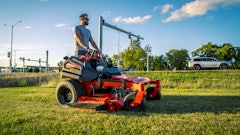
Anyone close to the landscaping industry, or even someone watching from a distance, has recognized that the slick zero-turn riding mower is the product of choice for most end-users. Then why is it that manufacturers continue to build intermediate walk mowers, dealers continue to sell them and landscapers continue to buy them?
HILLSIDE MOWING
For landscape contractors, there are still certain applications where a walk mower is the best design. Roy Dust, a product specialist for Ferris, points to hillside mowing as one of them. “Due to their better traction and handling, walk mowers are safer and better suited to the conditions,” Dust explains.
Still, design improvements have made some mid-mount zero-turn riders safer and more effective on hillsides. Furthermore, stand-on zero-turn mowers, which are more commonly available than in the past, have also taken some market share from walk mowers, due in part to their effectiveness on slopes, along with the price point on some models.
PRICE, PERCEPTION & PROPERTY SIZE
For the past several years, entry price has been a primary reason landscapers would opt for an intermediate walk-behind. Price is still influential today, but often must work in concert with several other factors.
“Dealers are selling intermediate walk mowers to entry-level contractors who want a lower entry price, are servicing areas where yards are small and fences are popular, and labor is inexpensive,” says Greg Heyer, director of distribution and rental sales for Commercial Grounds Care Inc. (CGC).
“Even in larger commercial areas,” Heyer continues, “there are often portions of a property that aren’t accessible with a riding mower. In those areas, quality of cut is less important to the customer. A quality cut and reduced labor costs can be achieved by the use of a single worker with a walk-behind mower in these areas.”
Dust says contractors with a lot of inter-city accounts are also good prospects for a walk mower. “Properties are smaller and feature more landscaping,” Dust points out. “Smaller trailers, and even van-bodied trucks and pickups, can transport walk mowers easily.”
There’s also the issue of customer perception. “In the older commercial markets, the actual customer either doesn’t want a big rider on their lawn, or they think they are paying too much because the worker is not working hard enough,” Dust relates. “Sounds stupid, but I can’t tell you how many times I have gotten that feedback from
landscapers.”
The latest trend Dust is seeing is a return to walk mowers because operators are tearing too much turf with riders. Plus, with a crew using walk mowers, the mowing operator cuts the grass and then assists in finishing the job (string trims, blows, picks up debris, etc.). “When the mower operator is mowing on a rider, he tends to milk it a bit so he doesn’t have to help out with the finishing tasks,” Dust says.
When you look at it that way, an intermediate walk-behind mower might actually be the more productive tool. But that’s more of a personnel issue than an equipment one. One thing is certain: Intermediate walk mowers are not the commodities some landscapers have come to view them as.
“Maybe some landscapers view them that way because their businesses have changed and now include more larger properties,” Heyer says. “While the walk mower is not the most efficient tool for these large-area jobs, it is still probably the product that got most landscapers where they are today—and remains a staple in their arsenal of power tools.”
To determine if you have a need for an intermediate walk mower, you have to be aware of the turf conditions in your area. You should also know the size and layout of the residential and commercial properties, because common gate widths will help you decide on deck sizes. Finally, understand the wear and tear your operators can put on a walk-behind mower.
“The mowers need to meet those requirements first,” Heyer points out. “Plus, they have to deliver a professional-quality cut. Then you’re looking at features that make operation easier, reduce user fatigue, and so on. Don’t forget about maintenance—look for units that require minimal maintenance and have a good manufacturer’s warranty.”
On that note, don’t forget about intermediate walk mowers in general. While riders are outselling them 6-1, they still have their place in the hearts of most landscapers—and also in their equipment fleets.








![Gravely Pro Turn Mach One My23 Dsc03139 Edit 1200x800 5b2df79[1]](https://img.greenindustrypros.com/mindful/acbm/workspaces/default/uploads/2025/10/gravely-pro-turn-mach-one-my23-dsc03139-edit-1200x800-5b2df791.BucBnDoN22.jpg?ar=16%3A9&auto=format%2Ccompress&fit=crop&h=135&q=70&w=240)









![U8kj71gt 720[1]](https://img.greenindustrypros.com/mindful/acbm/workspaces/default/uploads/2025/10/u8kj71gt-7201.8OyDyc124u.jpg?ar=16%3A9&auto=format%2Ccompress&fit=crop&h=135&q=70&w=240)
